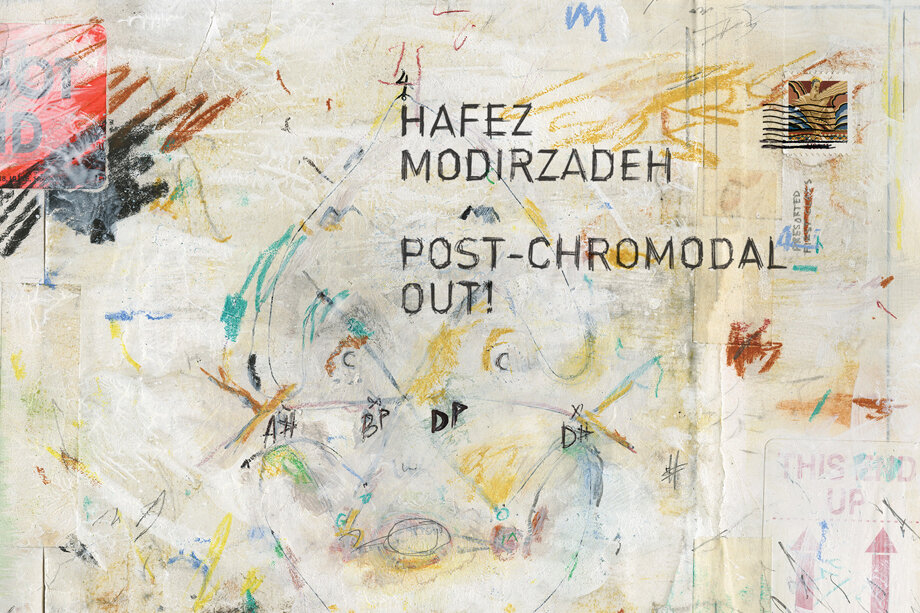Hafez Modirzadeh: Post-Chromodal Out!
 Speaking about the saxophonist Hafez Modirzadeh, the pianist Vijay Iyer proclaims:
Speaking about the saxophonist Hafez Modirzadeh, the pianist Vijay Iyer proclaims:
The scope of Hafez’s synthesis of concepts across cultures is staggering. There is great detail in his critical engagement with traditional intervallic systems, tuning systems, and modes, and there is also a grand sweep to his vision across disciplines and historical eras. In spite of its technical complications, there is genuine heart to this music and a real spiritual clarity. Modirzadeh is not simply a ‘scholar’ or ‘musicologist,’ but a genuine artist, with a profound, lifelong stake in the unification of research, creative work, and personal inner quest that is expressed in his music.
Hafez grew up in Northern California, and got his start on the horn at age 12. Before long, he was moonlighting at the Keystone Corner club, learning and drawing inspiration from the great saxophonists that came through town: Sonny Stitt, Dexter Gordon, James Moody, Joe Henderson, and Sonny Simmons. Hafez began to dialog with the music of his ancestry early, taking lessons in the Persian dastgah in his formative years with the renowned musician Mahmoud Zoufonoun. He also performed and recorded internationally with the likes of Don Cherry, Zakir Hussain, Steve Lacy, Oliver Lake, George Lewis, and others.After earning degrees from New England Conservatory, UCLA, and Wesleyan University, and cutting his teeth on the New York scene, the saxophonist returned to California to teach; he is currently a Music Professor of World Cultures at San Francisco State University. He spent his early years there developing his pioneering “chromodal” concept, a cross-cultural musical approach developed from his own American jazz and Iranian dastgah heritages. Chromodality allows the practitioner to piece together elements of different musical languages from around the world while carefully respecting the traditions of each.However, a chance encounter with one of the world's greatest reedists inspired Hafez to take his ideas into the next stage of development. The press release from Pi Recordings tells the story best:
As years turned into decades, and although awarded two NEA Fellowships and a Fulbright, still, the feeling never escaped Modirzadeh that his life’s work was slowly dying on the vine. The story might have ended there if not for a serendipitous visit to Ornette Coleman’s home in New York City in 2007. Modirzadeh had been interested in finding out how it was that after years of developing his own musical approach through Persian and various other non-western systems that he would somehow arrive at a tonal language similar to Coleman’s. A single afternoon visit turned into days of discussion and playing, leaving Modirzadeh convinced of the need for a universal “post-chromodal” approach that breaks free of all cultural barriers. Consequently, Coleman invited Modirzadeh to play with him at the 2007 San Francisco and Monterey Jazz Festivals.
Soon thereafter, Hafez met the Iraqi-American trumpeter Amir ElSaffar; the connection was instantaneous. I sat down with Hafez for an interview yesterday (snippets are included below, but stay tuned for a lengthier version in the weeks ahead) in which he elaborated:
Amir ElSaffar can play every clean shade of any note without any alteration to his horn - just a slide and his embrasure. That's a training that he received not only from studying classical music, or from the equilibrium of Cecil Taylor's sonic world, but also from the Iraqi Maqam. He's coming from Iraqi Maqam and I'm coming from Persian Dastgah - they share this value system of resonance. We both just take that as another inspiration, but what it has done is train our ears. Now, his ears are something else! He's fifteen years younger than me and it took me like twenty years to get what he got in five, but everybody is different!
Hafez points to the way in which the rhythmic vocabulary of improvised music has developed over the course of the last quarter century as a predecessor to a current revolution in the way we think about resonance: "Rhythm in this music over the last 25 years or so has come to such a sophisticated level. You see rhythmic components being abstracted from and inspired by these cultural traditions, but they recombine and reassemble organically, and in a way that transcends time and place, and reveals something deeply human."Hafez's new release on Pi Recordings, Post-Chromodal Out!, is a manifesto in resonance. On it, you hear Hafez's barrier-breaking new "post-chromodal" approach embodied by Vijay Iyer, who plays a de-tuned piano; the front-line team of Hafez and Amir ElSaffar, whose previous collaboration Radif Suite (Pi) was described by The New York Times as “scintillating… a radical cultural exchange;” and the rhythm section of Ken Filiano and Royal Hartigan, with whom Hafez has been working for decades.Hafez seeks to collapse cultural boundaries in the pursuit of a new idea of resonance:
The standardized temperament for piano, as beautiful as it is, carries an unbalanced weight of influence over players and listeners, leading many to believe that there is no other resonance to work with but this one. This creates a value system that is unjust and ultimately limits the discovery of other, more personal tuning possibilities. By retuning the piano – the one instrument that imposes a dominant influence on the world’s music – the musician is freed to explore all tonal possibilities.
In our conversation yesterday, the saxophonist added:
I feel so grateful to be at the source of a link in a very long chain, and over time, other links will take shape. Subsequently, we'll have pianists - creative pianists, hopefully some brilliant ones in the mix - carrying that hammer, that tuning hammer, to build their own house!
Want to hear what the music sounds like? Stream the second track, "Facet Fourteen," from Post-Chromodal Out! below, or just go ahead and reserve your tickets for the CD Release Party at The Jazz Gallery this Friday night.[audio https://www.jazzspeaks.org/wp-
